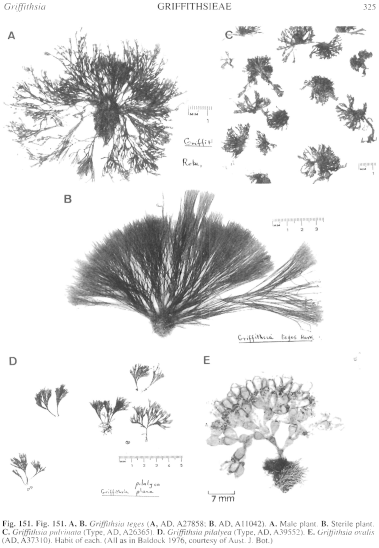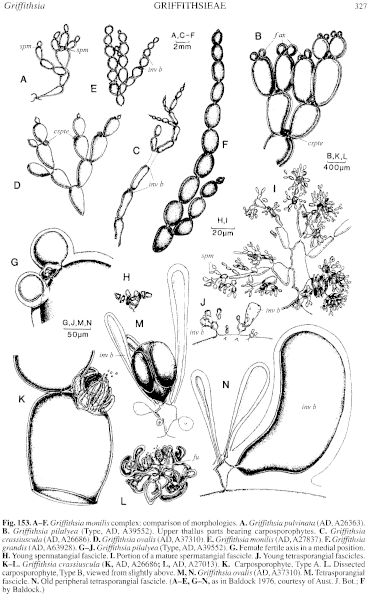|
|
|
|
|
|||||||||||
|
Electronic Flora of South Australia Species Fact Sheet
Phylum Rhodophyta – Order Ceramiales – Family Ceramiaceae – Tribe Griffithsieae
Thallus (Fig. 151D) light red, complanately and flabellately branched, regularly subdichotomous, 1.7–4.5 cm high, constricted between cells, ecorticate. Attached by slender rhizoids from the thallus base; epilithic. Structure. Cells (Fig. 153B) near the thallus apex ovoid-globose, 0.6–0.9 mm in diameter and L/D 1–1.5, in the mid thallus obovoid-pyriform, 0.8–1.0 mm in diameter and L/D 1.8–2.8, but near the thallus base cylindrical, 0.4–1.1 mm in diameter and L/D 2.5–4.
Reproduction: Gametophytes dioecious. Female axes (Fig. 153G) of 3 small, discoid cells, arising subapically but quickly displaced to axillary positions in the forks of dichotomies by the development of further vegetative laterals, resulting in regular ranks of carposporophytes across the thallus (Fig. 153B). Procarp systems subapical, each with a sterile lateral cell and a supporting cell bearing a sterile cell apical ly and laterally a recurved carpogonial branch of 4 cells; hypogenous cell producing abaxially 7–10, 2-celled, synchronic involucral branches, of which the larger, incurved, apical cells are ovoid, 110–365 µm in diameter and L/D 1.3–2; post-fertilisation fusion cell columnar, bearing 1–3 gonimolobes terminally, most cells of which produce globose-ovoid carposporangia 45–50 µm in diameter. Spermatangia borne on numerous minute fascicles from upper ends of cells near the thallus apex, clustered in the constrictions between cells; involucre absent. A fascicle at first (Fig 153H) resembles an immature synchronic hair-like lateral, with an urceolate basal cell producing 4–5 laterals which become terete and bear di-polychotomous branches of small cells producing 1–2 spermatia terminally (Fig. 153I).
Tetrasporangia produced successively on whorls of minute fascicles in similar positions to spermatangial fascicles; fascicles innermost in a cluster each consist of an urceolate cell (Fig. 153J) producing successively 2–7 lachrimiform tetrasporangia tetrahedrally divided; outermost fascicles each producing an inflated, incurved, ovoid-clavate involucral cell 90– 156 in diameter and L/D 1–1.3, 2–3 times the size of a tetrasporangium, and forming a composite involucre about clusters.
Type from Nora Creina, S. Aust., upper sublittoral pools, shaded (Womersley, 3.ix.1971); holotype and isotypes in AD, A39552 –"Marine Algae of southern Australia" No. 176.
Selected specimens: Robe, S. Aust., upper sublittoral shaded pool (Womersley, 9.ix.1968; AD, A32844). Nora Creina, S. Aust., shaded pool (Womersley, 1.xi.1993; AD, A63251).
Distribution: Known only from the south-east of S. Aust., in heavily shaded sublittoral rock pools, and just below low water level.
Taxonomic notes: G. pilalyea is very similar reproductively to G. monilis, but the vegetative cells (Fig. 153B, E) are smaller and ovoid, and the thallus is distinctly flabellate with a regular and complanate branching pattern.
References:
BALDOCK, R.N. (1976). The Griffithsieae group of the Ceramiaceae (Rhodophyta) and its southern Australian representatives. Aust. J. Bot. 24, 509–593.
The Marine Benthic Flora of Southern Australia Part IIIC complete list of references.
Publication:
Womersley, H.B.S. (24 December, 1998)
The Marine Benthic Flora of Southern Australia
Rhodophyta. Part IIIC. Ceramiales – Ceramiaceae, Dasyaceae
©State Herbarium of South Australia, Government of South Australia
Illustrations in Womersley Part IIIA, 1998: FIGS 151D, 153B, G–J.

Figure 151 enlarge
Fig. 151. A, B. Griffithsia teges (A, AD, A27858; B, AD, A 11042). A. Male plant. B. Sterile plant. C. Griffithsia pulvinata (Type, AD, A26365). D. Griffithsia pilalyea (Type, AD, A39552). E. Griffithsia ovalis (AD, A37310). Habit of each. (All as in Baldock 1976, courtesy of Aust. J. Bot.)

Figure 153 enlarge
Fig. 153. A–F. Griffithsia monilis complex: comparison of morphologies. A. Griffithsia pulvinata (AD, A26363). B. Griffithsia pilalyea (Type, AD, A39552). Upper thallus parts bearing carposporophytes. C. Griffithsia crassiuscula (AD, A26686). D. Griffithsia ovalis (AD, A3731.0). E. Griffithsia monilis (AD, A27837). F. Griffithsia grandis (AD, A63928). G–J. Griffithsia pilalyea (Type, AD, A39552). G. Female fertile axis in a medial position. H. Young spermatangial fascicle. I. Portion of a mature spermatangial fascicle. J. Young tetrasporangial fascicles. K–L. Griffithsia crassiuscula (K, AD, A26686; L, AD, A27013). K. Carposporophyte, Type A. L. Dissected carposporophyte, Type B, viewed from slightly above. M, N. Griffithsia ovalis (AD, A37310). M. Tetrasporangial fascicle. N. Old peripheral tetrasporangial fascicle. (A–E, G–N, as in Baldock 1976, courtesy of Aust. J. Bot.; F by Baldock.)

|
Email Contact: State Herbarium of South Australia |

|